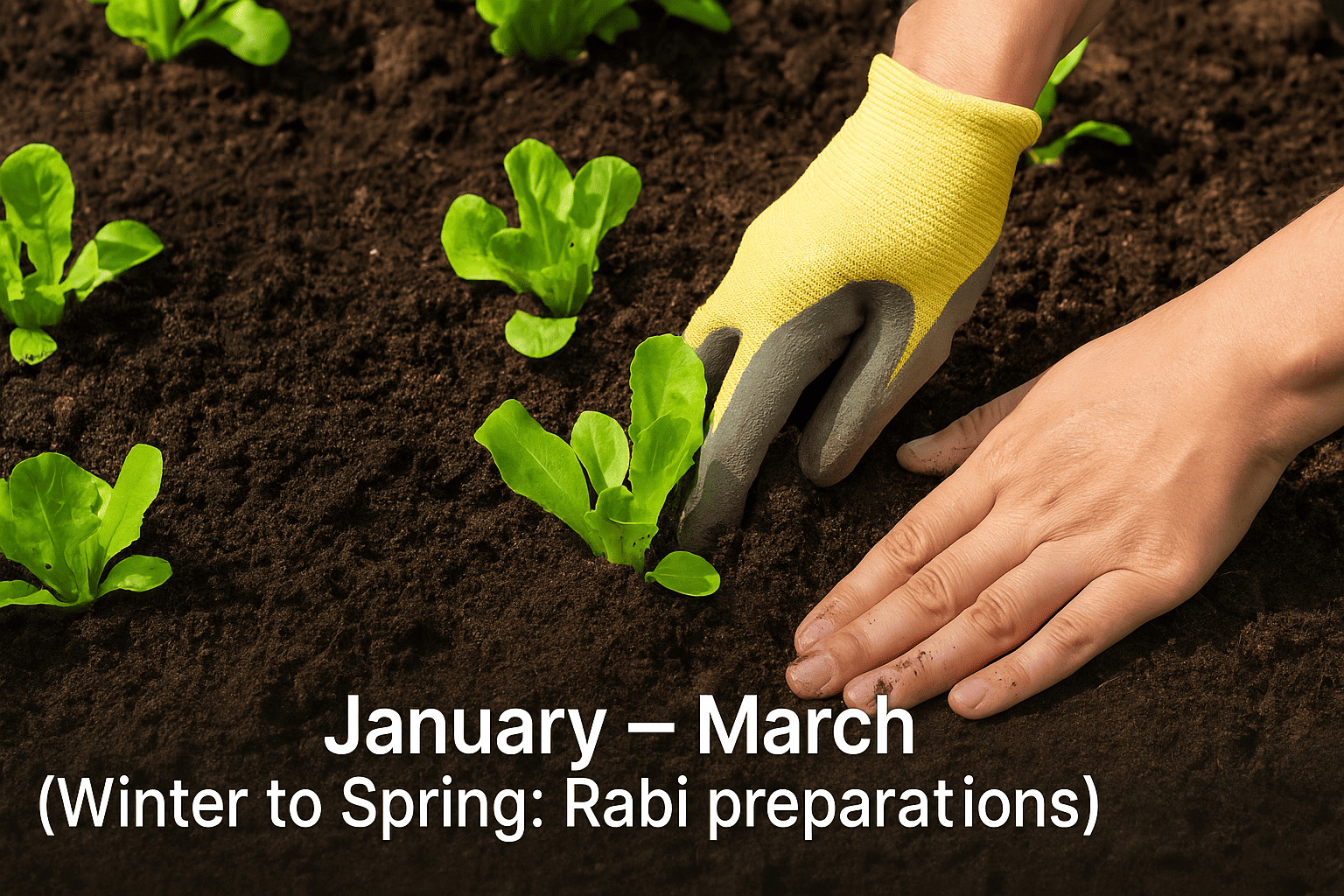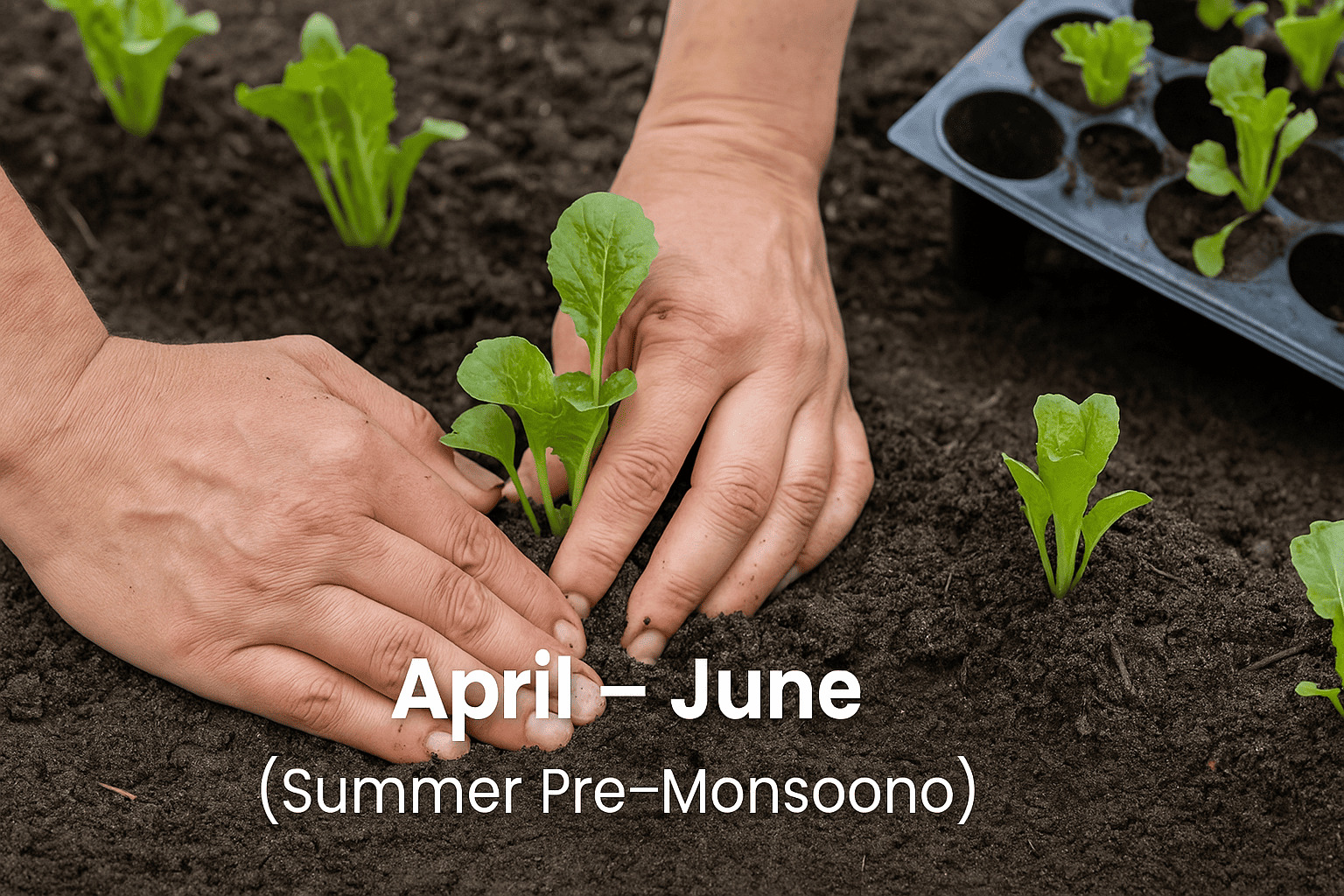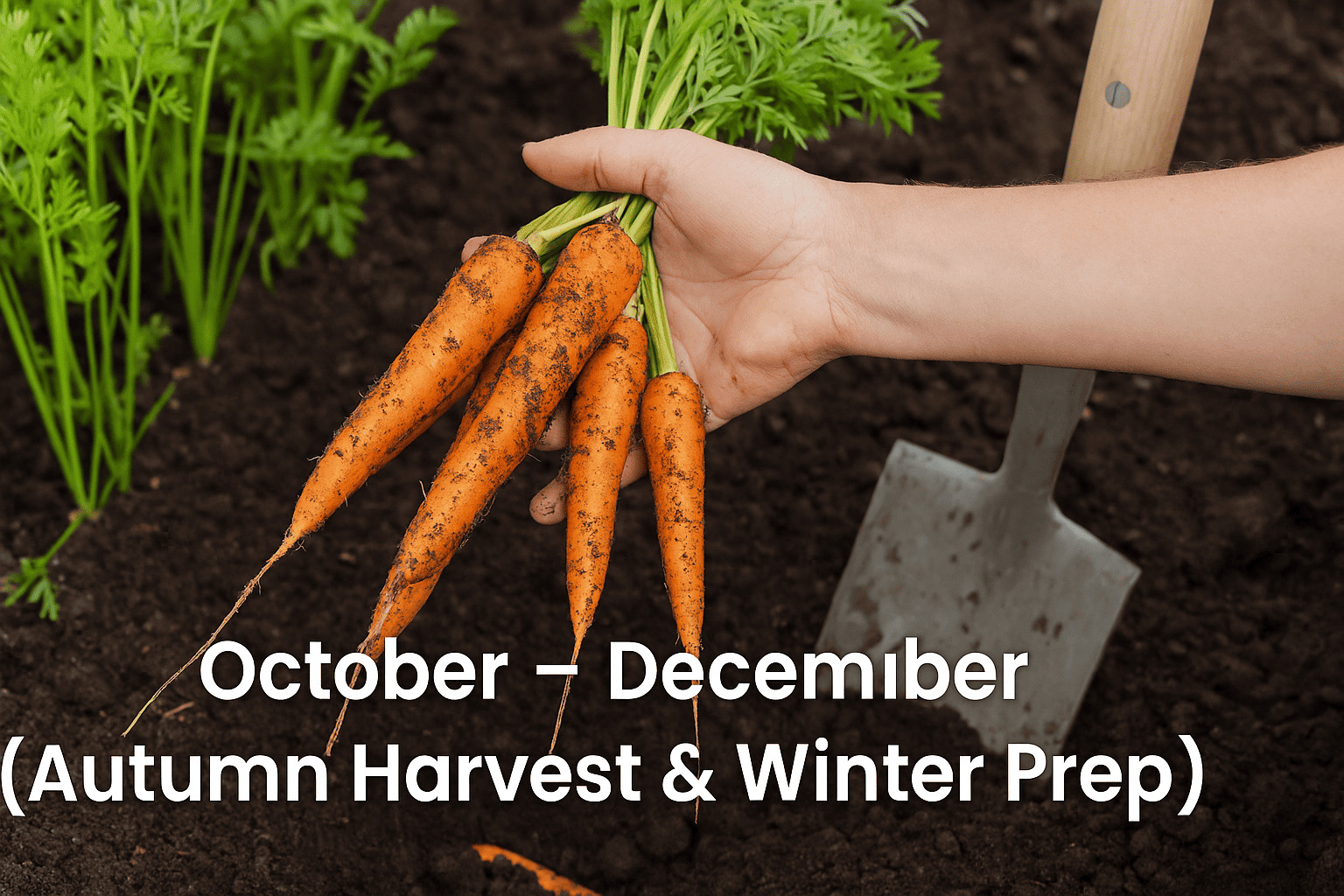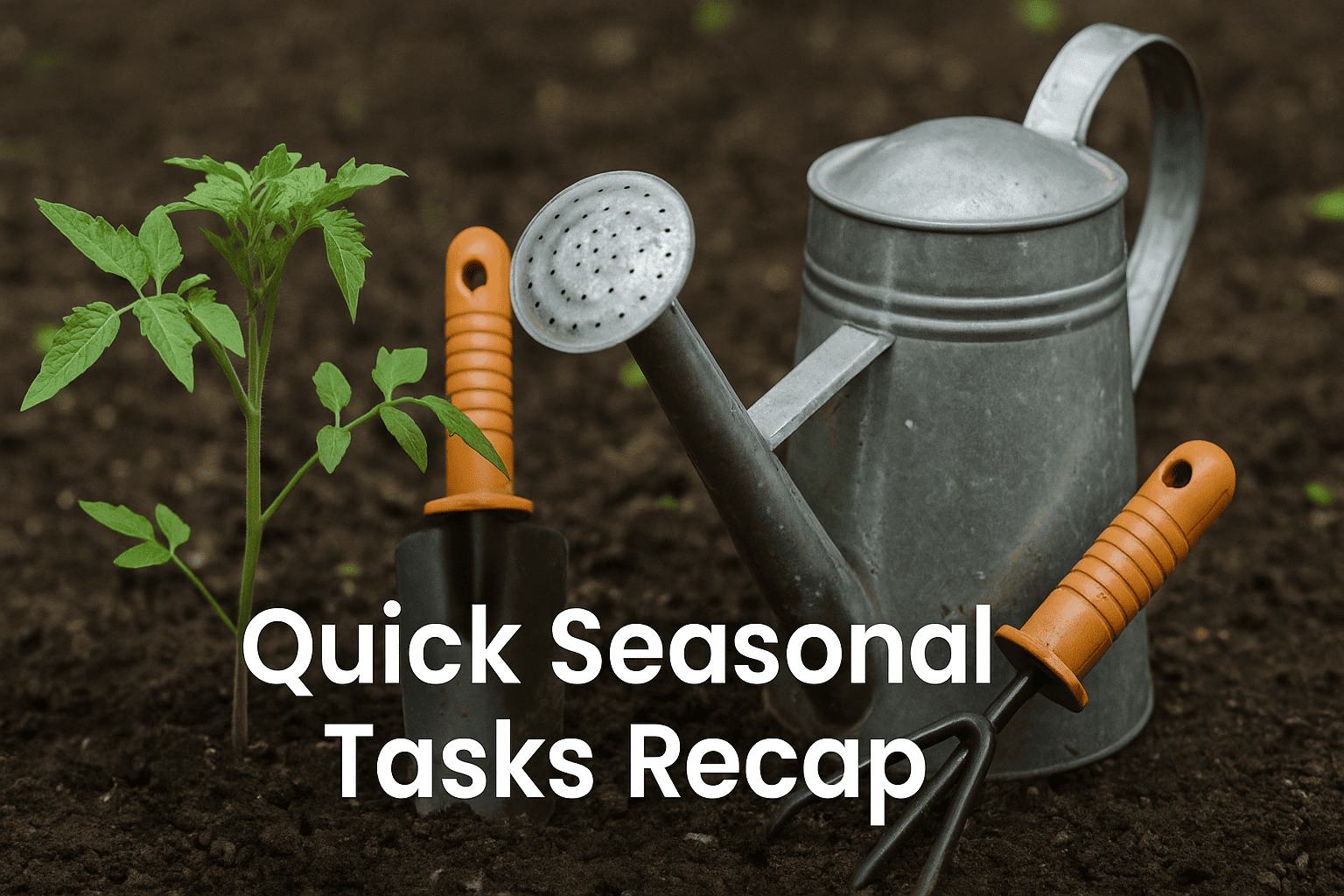.jpg)
Planning what to plant and when is key to successful home gardening in India. A Gardening Calendar India approach helps urban balcony and patio gardeners grow fresh veggies year-round.
By following a month-by-month and seasonal schedule, even beginners can time their Vegetable Growing Season correctly.
For example, seeds need adequate moisture and the right soil temperature to germinate – APEDA notes an optimum range of about 4–40°C.
Matching sowing dates to our climate windows (pre-monsoon, monsoon, post-monsoon, and winter) ensures plants thrive.
In practice, use a Planting Calendar (even an online one) to plan sowing.
Many gardeners even follow charts of “fruits and vegetables in season by month” to pick crops that peak at just the right time for harvesting.
In India we broadly have Kharif (monsoon) crops (sown June–July, harvested Sept–Oct), Rabi (post-monsoon, sown Oct–Nov, harvested Feb–Mar), and a short Zaid season (summer, Mar–June).
Each window favors different vegetables. Below is a friendly, month-by-month guide, with practical tips (and festive tie-ins) for beginner gardeners.
Vegetable Seeds Sowing Calendar Table
| Vegetable Name | Growing Season – North India | Growing Season – South India | Germination Temp (°C) | Best Sowing Months | Quick Gardening Tip |
|---|---|---|---|---|---|
| Tomato | Feb–Apr, Jul–Sep | Jan–Mar, Aug–Sep | 20–30 | Feb, Mar, Apr, Jul, Aug, Sep | Stake early for strong growth. |
| Brinjal (Eggplant) | Mar–May, Jul–Sep | Jan–Mar, Jul–Sep | 20–30 | Mar, Apr, May, Jul, Aug, Sep | Transplant at 4–6 leaf stage. |
| Okra | Feb–Jun, Jul–Sep | Jan–Jun, Jul–Sep | 25–35 | Feb–Sep | Harvest pods every 2 days. |
| Spinach | Oct–Mar | Oct–Feb | 15–25 | Oct–Mar | Harvest leaves while young. |
| Carrot | Oct–Feb | Oct–Jan | 15–25 | Oct–Feb | Use deep, loose soil. |
| Radish | Sep–Feb | Sep–Jan | 15–30 | Sep–Feb | Thin out seedlings early. |
| Coriander | Sep–Mar | Aug–Feb | 20–25 | Sep–Mar | Sow every 2 weeks for supply. |
| Cucumber | Mar–May, Jun–Jul | Jan–Mar, Jun–Jul | 25–35 | Mar–Jul | Trellis for better airflow. |
| Beans | Mar–May, Jul–Sep | Jan–Mar, Jul–Sep | 20–30 | Mar–Sep | Soak seeds overnight. |
| Peas | Oct–Dec | Sep–Nov | 15–20 | Oct–Dec | Sow early before frost ends. |
| Bottle Gourd | Feb–May, Jul–Sep | Jan–May, Jul–Sep | 25–35 | Feb–Sep | Use grow bags on balconies. |
| Bitter Gourd | Mar–Jun, Jul–Sep | Jan–Mar, Jul–Sep | 25–35 | Mar–Sep | Harvest while tender. |
| Pumpkin | Feb–May, Jul–Sep | Jan–May, Jul–Sep | 25–35 | Feb–Sep | Plant in raised beds. |
| Beetroot | Oct–Feb | Oct–Jan | 15–25 | Oct–Feb | Keep soil evenly moist. |
| Fenugreek (Methi) | Oct–Mar | Oct–Feb | 15–25 | Oct–Mar | Also great for microgreens. |
January – March (Winter to Spring: Rabi preparations)

1. Veggies to Grow
In winter you can grow leafy greens and root vegetables.
Think spinach, fenugreek (methi), mustard greens, carrots, radishes, beets, cauliflower, cabbage, and peas.
For example, spinach thrives in cool weather. Spinach is rich in iron and vitamins and grows well in moist, fertile soil.
Sowing spinach or lettuce seeds in February–March gives you salad greens before the heat sets in.
2. Tasks
Harvest any remaining winter crops. Prepare soil by adding organic matter: mix in vermicompost or cow manure before planting new veggies.
For instance, mix cow manure 1:2 with garden soil as a bed base.
This boosts nitrogen, phosphorus and potassium for healthy growth.
Sow early spring vegetables (like coriander, carrot, onion transplants) by mid-February. Keep pots moist and fertilize with a balanced organic fertilizer.
3. Balcony Tip
Use containers or railing planters to maximize space. Hanging planter sets or wall pockets let you grow more in a small area【105†】.
A planter with drainage holes and hooks (see image below) is ideal for growing herbs and greens right by your kitchen.
Start seeds in small pots or seed trays indoors or on a bright windowsill before transplanting out.
4. Festivals
By late January, festival events like Makar Sankranti signal the start of spring.
In February, plant windows should consider Holi – some gardeners sow marigolds (genda) in February so they bloom in March for Holi decorations.
Read Also
How to Start a Small Balcony Kitchen Garden in India (Beginner-Friendly Vegetable Guide)
Why Your Plants Struggle? How to Choose the Right Potting Soil Mix for Plants
April – June (Summer Pre-Monsoon)

1. Veggies to Grow in Summer
As days warm, focus on heat-tolerant crops and summer vegetables. Start sowing seeds indoors or in shade in early March so transplants are ready by April.
Good choices include tomatoes, brinjal (eggplant), bell peppers, chili peppers, okra, and cucumbers.
These love sun and warm nights. Chilies and tomatoes can also be sown during summer. Green chilies in particular do well even in moist, pre-monsoon soil.
2. Gardening Tasks in Summer
April can be very hot; water deeply in the mornings and mulching to conserve moisture.
Fertilize young plants monthly with organic compost or balanced fertilizer.
Continue sowing quick-growers like beans and gourds – they will climb up trellises or railing planters.
As the monsoon approaches (June), prepare by clearing weeds and readying new seedbeds.
3. Balcony Gardening Tips in Summer
If you haven’t already, upgrade to self-watering pots or add a watering wick – hot sun can dry small pots quickly.
Also top-dress containers with more compost or potting mix about once a month (for example, after harvest).
Urban Plant’s Vermicompost is an excellent choice here for a gentle, organic feed to keep potted veggies healthy.
4. Festivals In Summer for Gardening Calendor
In April-May many families celebrate Akshaya Tritiya or Hanuman Jayanti.
It’s a lucky time, so even urban gardeners may plant a sacred Tulsi (holy basil) or a Neem tree.
5. Pests
Be vigilant for heat-loving pests like aphids or fruit flies. Use neem oil or soapy water if needed.
July – September (Monsoon Season)

1. Veggies to Grow in July-September
The monsoon is prime time for Kharif vegetables. Sowing during rains gives high yields.
Excellent choices: Okra (ladyfinger), broad beans (French beans, cluster beans), gourds (bottle gourd, bitter gourd), pumpkin, bottle gourd, snake gourd, and corn.
Also spices like turmeric and ginger that can be planted now. Brinjal (eggplant) loves this season too – it needs full sun between rains.
During consistent rains, leafy greens like spinach and amaranth still grow well. In fact, spinach does fine with partial to full sun and wet soil.
2. Tasks
The heavy rains mean you must focus on drainage and disease prevention. Ensure pots have extra drainage holes.
If waterlogging occurs, carefully lift plants to dry or amend soil with sand/compost for better aeration.
Keep feeding with compost tea or light organic fertilizer every 2-3 weeks.
This is also a good time to mulch heavily (straw or cocopeat) to prevent soil from washing away. Regularly check for slugs or fungal infections.
3. Composting for Mansson Gardening
Use this season’s lush growth: compost fallen leaves and kitchen greens.
Apply a good dose of compost or manure in July to replenish nutrients that heavy rain can leach.
Cow manure spread thinly around plants (top-dressing) once a month is beneficial.
Urban Plant sells pure Cow Manure compost you can mix in potting mix or garden beds.
4. Garden Kit
Consider a seasonal sowing kit for monsoon.
A kit containing okra, bean, and gourd seeds (like Urban Plant’s Seed Combo) can simplify planning – all seeds matched for the rainy season.
5. Festivals
In August, Raksha Bandhan and Janmashtami come around. It’s auspicious to have flowering plants.
Sow marigolds or zinnias early in Aug so they bloom by autumn festivals.
October – December (Autumn Harvest & Winter Prep)

1. Veggies to Grow in October – December (Winter)
October marks the start of Rabi preparations. The weather cools, making it ideal to sow winter vegetables: spinach, fenugreek, mustard greens, radishes, carrots, beets, peas, fenugreek, and turnips.
October–November is the prime sowing time for these leafy and root crops. Plant coriander (cilantro) and dill now for winter herbs.
By late November, start warm-season herbs like curry leaf (bringing them indoors or in sunny spots for winter).
2. Tasks for Winter Gardening
After the monsoon, clear out spent summer crops and add compost. Sow cool-season seeds every few weeks into December for staggered harvests.
Continue mulching to protect soil moisture. As the nights drop, move tender potted plants (tomatoes, peppers) to a protected sunny corner or indoors.
Maintain containers with fresh potting mix (a mix with compost like vermicompost will keep them fertile through winter).
Watering can be reduced in cool months, but don’t let soil dry out completely.
3. Festival Tip
Before Diwali (usually Oct/Nov), it’s traditional to have marigold flowers on hand for decorations. So sow marigold seeds 6–8 weeks before Diwali.
In India, marigolds are symbolic in Diwali rangoli and garlands – planting them now means bright orange blooms just in time.
This not only adds color to your urban garden, but gives you “festival ready” flowers straight from home.
4. Winter preparations
By December, cover tender root crops if any cold snaps come (especially in North India).
Apply a final light dressing of manure or compost under leafy greens (spinach and methi appreciate extra nutrients).
Use Urban Plant’s vermicompost or cow manure conservatively to feed winter crops without burning tender roots.
Boost soil fertility for winter crops. Top-dress vegetable beds or pots with organic matter like cow manure or compost about every 4–6 weeks. This enriches the soil (N-P-K) and supports lush winter growth.
Year-Round Balcony Gardening

Even if you only have a balcony, you can follow the Vegetable Seeds Sowing Calendar. With clever container use, many vegetables can be grown year-round.
For example, grow herbs (basil, mint, coriander) and leafy greens in pots in winter, and move them to cooler spots in summer. Deep pots (12–14 inch) can handle tomatoes, beans and chilies.
Use kits like Urban Plant’s Balcony Gardening Kit, which bundles essentials (planters, stakes, seeds) for beginners.
Choose lightweight soil mixes (coir-based or potting mix with vermicompost) so you don’t overload your terrace.
Choose the right container. A sturdy hanging or pot planter (with drainage) lets you grow vegetables even on a small balcony.
Many balcony kits include railing planters and drip trays to make container gardening easy.
Follow an online Planting Calendar (many Indian gardening sites offer month-wise charts) to know which seeds to sow.
For example, an online "Vegetable Growing Season Chart India" might show spinach and radish under October–March (winter), and okra and brinjal under June–September (monsoon).
These charts (similar to a fruits and vegetables in season by month chart in India) help you visualize what to plant now vs later.
Remember, local climate matters: South India gardeners can often start winter crops a month earlier (Sept) and sow summer crops later in the spring.
Quick Seasonal Tasks Recap:

- Monsoon (Jun-Sep): Sow okra, beans, gourds, pumpkins. Keep pots drained. Apply compost. Use rainwater if possible.
- Autumn (Oct-Nov): Sow spinach, carrot, radish, peas. Plant flowering marigolds for festivals. Pull out warm-season crops.
- Winter (Dec-Jan): Maintain leafy greens; fertilize lightly with manure or compost. Protect any frost-sensitive plants.
- Spring (Feb-May): Start seeds indoors for summer (tomato, pepper). Prepare soil with organic matter. Update potting mixes in planters.
FAQs on Vegetable Seeds Sowing Calendar India
What is the best month to sow vegetable seeds in India?
October to March is ideal for winter vegetables; February to September suits summer crops.
Which vegetables grow best in monsoon in India?
Okra, bitter gourd, bottle gourd, and brinjal thrive during June to September.
Can I grow vegetables year-round in India?
Yes, using a month-wise vegetable planting calendar tailored for Indian climates.
What are the top vegetables to sow in October in India?
Spinach, peas, fenugreek, carrots, and beets are best for October sowing.
How to start vegetable gardening in South India?
Start early: sow summer crops in January and winter crops by September.
What temperature is needed for vegetable seed germination?
Most vegetable seeds germinate between 15°C to 35°C based on crop type.
Where can I find a vegetable sowing calendar for India?
You can use Urban Plant’s online sowing calendar or refer to ICAR guidelines.
What are easy balcony vegetables to grow monthly in India?
Spinach, methi, tomatoes, radish, and coriander grow well all year on balconies.
Which season is best for planting leafy greens in India?
October to February is perfect for growing leafy greens like spinach and methi.
How to grow vegetables on a terrace using a planting calendar?
Use containers, check sowing months, and follow region-specific planting schedules.
Conclusion
By following this Gardening Calendar, you’ll align your planting with India’s unique seasons (Rabi, Kharif, Zaid) and festivals.
Stay flexible: watch the weather and adjust sowing a few weeks early or late if the monsoon comes early/late.
Regularly add organic matter (vermicompost, cow manure) and mulch to keep your soil fertile and moist.
Urban gardeners have great resources too – Urban Plant offers seasonal sowing kits like a Winter Vegetable Seed Bank, as well as compost options and Balcony Planters to help you set up.
With a little planning and these clear monthly tasks, even a balcony gardener can harvest fresh veggies all year!





